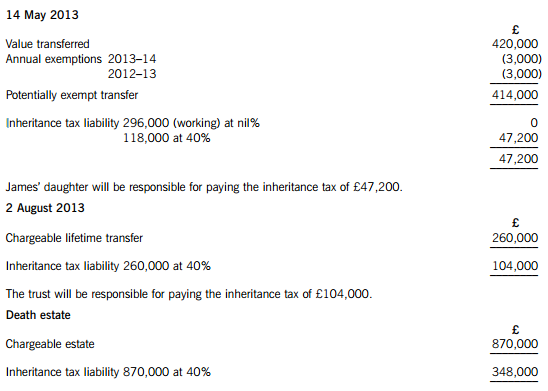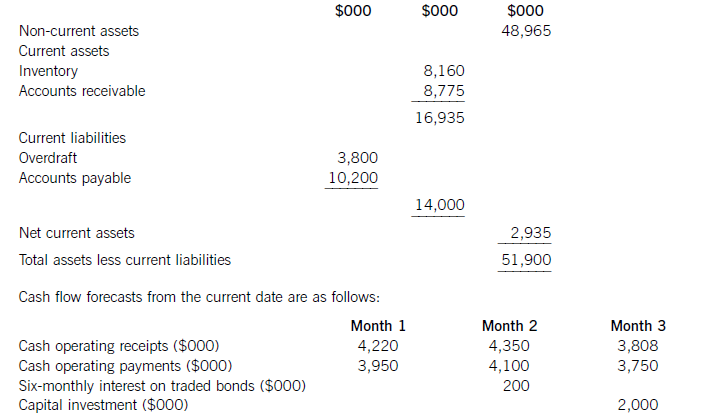CPA与ACCA是否有互免政策呢?
发布时间:2021-03-11
CPA与ACCA是否有互免政策呢?
最佳答案
没有互勉政策了。
09年之前通过的CICPA全科通过免试5门课程(F1-F4和F6)09年新政后通过cicpa全科可以免试ACCA前9门课程。
目前暂未有任何一张证书可以免考ACCA P阶段考试。
下面小编为大家准备了 ACCA考试 的相关考题,供大家学习参考。
James died on 22 January 2015. He had made the following gifts during his lifetime:
(1) On 9 October 2007, a cash gift of £35,000 to a trust. No lifetime inheritance tax was payable in respect of this gift.
(2) On 14 May 2013, a cash gift of £420,000 to his daughter.
(3) On 2 August 2013, a gift of a property valued at £260,000 to a trust. No lifetime inheritance tax was payable in respect of this gift because it was covered by the nil rate band. By the time of James’ death on 22 January 2015, the property had increased in value to £310,000.
On 22 January 2015, James’ estate was valued at £870,000. Under the terms of his will, James left his entire estate to his children.
The nil rate band of James’ wife was fully utilised when she died ten years ago.
The nil rate band for the tax year 2007–08 is £300,000, and for the tax year 2013–14 it is £325,000.
Required:
(a) Calculate the inheritance tax which will be payable as a result of James’ death, and state who will be responsible for paying the tax. (6 marks)
(b) Explain why it might have been beneficial for inheritance tax purposes if James had left a portion of his estate to his grandchildren rather than to his children. (2 marks)
(c) Explain why it might be advantageous for inheritance tax purposes for a person to make lifetime gifts even when such gifts are made within seven years of death.
Notes:
1. Your answer should include a calculation of James’ inheritance tax saving from making the gift of property to the trust on 2 August 2013 rather than retaining the property until his death.
2. You are not expected to consider lifetime exemptions in this part of the question. (2 marks)
(a) James – Inheritance tax arising on death
Lifetime transfers within seven years of death

The personal representatives of James’ estate will be responsible for paying the inheritance tax of £348,000.
Working – Available nil rate band

(b) Skipping a generation avoids a further charge to inheritance tax when the children die. Gifts will then only be taxed once before being inherited by the grandchildren, rather than twice.
(c) (1) Even if the donor does not survive for seven years, taper relief will reduce the amount of IHT payable after three years.
(2) The value of potentially exempt transfers and chargeable lifetime transfers are fixed at the time they are made.
(3) James therefore saved inheritance tax of £20,000 ((310,000 – 260,000) at 40%) by making the lifetime gift of property.
The following financial information relates to HGR Co:
Statement of financial position at the current date (extracts)

The finance director has completed a review of accounts receivable management and has proposed staff training and operating procedure improvements, which he believes will reduce accounts receivable days to the average sector value of 53 days. This reduction would take six months to achieve from the current date, with an equal reduction in each month. He has also proposed changes to inventory management methods, which he hopes will reduce inventory days by two days per month each month over a three-month period from the current date. He does not expect any change in the current level of accounts payable.
HGR Co has an overdraft limit of $4,000,000. Overdraft interest is payable at an annual rate of 6·17% per year, with payments being made each month based on the opening balance at the start of that month. Credit sales for the year to the current date were $49,275,000 and cost of sales was $37,230,000. These levels of credit sales and cost of sales are expected to be maintained in the coming year. Assume that there are 365 working days in each year.
Required:
(a) Discuss the working capital financing strategy of HGR Co. (7 marks)
(b) For HGR Co, calculate:
(i) the bank balance in three months’ time if no action is taken; and
(ii) the bank balance in three months’ time if the finance director’s proposals are implemented.
Comment on the forecast cash flow position of HGR Co and recommend a suitable course of action.
(10 marks)
(c) Discuss how risks arising from granting credit to foreign customers can be managed and reduced.
(8 marks)
(a)Whenconsideringthefinancingofworkingcapital,itisusefultodividecurrentassetsintofluctuatingcurrentassetsandpermanentcurrentassets.Fluctuatingcurrentassetsrepresentchangesinthelevelofcurrentassetsduetotheunpredictabilityofbusinessactivity.Permanentcurrentassetsrepresentthecorelevelofinvestmentincurrentassetsneededtosupportagivenlevelofturnoverorbusinessactivity.Asturnoverorlevelofbusinessactivityincreases,thelevelofpermanentcurrentassetswillalsoincrease.Thisrelationshipcanbemeasuredbytheratioofturnovertonetcurrentassets.Thefinancingchoiceasfarasworkingcapitalisconcernedisbetweenshort-termandlong-termfinance.Short-termfinanceismoreflexiblethanlong-termfinance:anoverdraft,forexample,isusedbyabusinessorganisationastheneedarisesandvariableinterestischargedontheoutstandingbalance.Short-termfinanceisalsomoreriskythanlong-termfinance:anoverdraftfacilitymaybewithdrawn,orashort-termloanmayberenewedonlessfavourableterms.Intermsofcost,thetermstructureofinterestratessuggeststhatshort-termdebtfinancehasalowercostthanlong-termdebtfinance.Thematchingprinciplesuggeststhatlong-termfinanceshouldbeusedforlong-terminvestment.Applyingthisprincipletoworkingcapitalfinancing,long-termfinanceshouldbematchedwithpermanentcurrentassetsandnon-currentassets.Afinancingpolicywiththisobjectiveiscalleda‘matchingpolicy’.HGRCoisnotusingthisfinancingpolicy,sinceofthe$16,935,000ofcurrentassets,$14,000,000or83%isfinancedfromshort-termsources(overdraftandtradepayables)andonly$2,935,000or17%isfinancedfromalong-termsource,inthiscaseequityfinance(shareholders’funds)ortradedbonds.ThefinancingpolicyorapproachtakenbyHGRCotowardsthefinancingofworkingcapital,whereshort-termfinanceispreferred,iscalledanaggressivepolicy.Relianceonshort-termfinancemakesthisriskierthanamatchingapproach,butalsomoreprofitableduetothelowercostofshort-termfinance.Followinganaggressiveapproachtofinancingcanleadtoovertrading(undercapitalisation)andthepossibilityofliquidityproblems.(b)Bankbalanceinthreemonths’timeifnoactionistaken:Workings:ReductioninaccountsreceivabledaysCurrentaccountsreceivabledays=(8,775/49,275)x365=65daysReductionindaysoversixmonths=65–53=12daysMonthlyreduction=12/6=2daysEachreceivablesdayisequivalentto8,775,000/65=$135,000(Alternatively,eachreceivablesdayisequivalentto49,275,000/365=$135,000)Monthlyreductioninaccountsreceivable=2x135,000=$270,000ReductionininventorydaysCurrentinventorydays=(8,160/37,230)x365=80daysEachinventorydayisequivalentto8,160,000/80=$102,000(Alternatively,eachinventoryday=37,230,000/365=$102,000)Monthlyreductionininventory=102,000x2=$204,000OverdraftinterestcalculationsMonthlyoverdraftinterestrate=1·06171/12=1·005or0·5%Ifnoactionistaken:Period1interest=3,800,000x0·005=$19,000Period2interest=3,549,000x0·005=$17,745or$18,000Period3interest=3,517,000x0·005=$17,585or$18,000Ifactionistaken:Period1interest=3,800,000x0.005=$19,000Period2interest=3,075,000x0.005=$15,375or$15,000Period3interest=2,566,000x0.005=$12,830or$13,000DiscussionIfnoactionistaken,thecashflowforecastshowsthatHGRCowillexceeditsoverdraftlimitof$4millionby$1·48millioninthreemonths’time.Ifthefinancedirector’sproposalsareimplemented,thereisapositiveeffectonthebankbalance,buttheoverdraftlimitisstillexceededinthreemonths’time,althoughonlyby$47,000ratherthanby$1·47million.Ineachofthethreemonthsfollowingthat,thecontinuingreductioninaccountsreceivabledayswillimprovethebankbalanceby$270,000permonth.Withoutfurtherinformationonoperatingreceiptsandpayments,itcannotbeforecastwhetherthebankbalancewillreturntolessthanthelimit,orevencontinuetoimprove.Themainreasonfortheproblemwiththebankbalanceisthe$2millioncapitalexpenditure.Purchaseofnon-currentassetsshouldnotbefinancedbyanoverdraft,butalong-termsourceoffinancesuchasequityorbonds.Ifthecapitalexpenditurewereremovedfromtheareaofworkingcapitalmanagement,theoverdraftbalanceattheendofthreemonthswouldbe$3·48millionifnoactionweretakenand$2·05millionifthefinancedirector’sproposalswereimplemented.GiventhatHGRCohasalmost$50millionofnon-currentassetsthatcouldpossiblybeusedassecurity,raisinglong-termdebtthrougheitherabankloanorabondissueappearstobesensible.Assumingabondinterestrateof10%peryear,currentlong-termdebtintheform.oftradedbondsisapproximately($200mx2)/0·1=$4m,whichismuchlessthantheamountofnoncurrentassets.AsuitablecourseofactionforHGRCotofollowwouldthereforebe,firstly,toimplementthefinancedirector’sproposalsand,secondly,tofinancethecapitalexpenditurefromalong-termsource.Considerationcouldalsobegiventousingsomelong-termdebtfinancetoreducetheoverdraftandtoreducethelevelofaccountspayable,currentlystandingat100days.(c)Whencreditisgrantedtoforeigncustomers,twoproblemsmaybecomeespeciallysignificant.First,thelongerdistancesoverwhichtradetakesplaceandthemorecomplexnatureoftradetransactionsandtheirelementsmeansforeignaccountsreceivableneedmoreinvestmentthantheirdomesticcounterparts.Longertransactiontimesincreaseaccountsreceivablebalancesandhencetheleveloffinancingandfinancingcosts.Second,theriskofbaddebtsishigherwithforeignaccountsreceivablethanwiththeirdomesticcounterparts.Inordertomanageandreducecreditrisks,therefore,exportersseektoreducetheriskofbaddebtandtoreducethelevelofinvestmentinforeignaccountsreceivable.Manyforeigntransactionsareon‘openaccount’,whichisanagreementtosettletheamountoutstandingonapredetermineddate.Openaccountreflectsagoodbusinessrelationshipbetweenimporterandexporter.Italsocarriesthehighestriskofnon-payment.Onewaytoreduceinvestmentinforeignaccountsreceivableistoagreeearlypaymentwithanimporter,forexamplebypaymentinadvance,paymentonshipment,orcashondelivery.Thesetermsoftradeareunlikelytobecompetitive,however,anditismorelikelythatanexporterwillseektoreceivecashinadvanceofpaymentbeingmadebythecustomer.Onewaytoacceleratecashreceiptsistousebillfinance.Billsofexchangewithasignedagreementtopaytheexporteronanagreedfuturedate,supportedbyadocumentaryletterofcredit,canbediscountedbyabanktogiveimmediatefunds.Thisdiscountingiswithoutrecourseifbillsofexchangehavebeencountersignedbytheimporter’sbank.Documentarylettersofcreditareapaymentguaranteebackedbyoneormorebanks.Theycarryalmostnorisk,providedtheexportercomplieswiththetermsandconditionscontainedintheletterofcredit.Theexportermustpresentthedocumentsstatedintheletter,suchasbillsoflading,shippingdocuments,billsofexchange,andsoon,whenseekingpayment.Aseachsupportingdocumentrelatestoakeyaspectoftheoveralltransaction,lettersofcreditgivesecuritytotheimporteraswellastheexporter.Companiescanalsomanageandreduceriskbygatheringappropriateinformationwithwhichtoassessthecreditworthinessofnewcustomers,suchasbankreferencesandcreditreports.Insurancecanalsobeusedtocoversomeoftherisksassociatedwithgivingcredittoforeigncustomers.Thiswouldavoidthecostofseekingtorecovercashduefromforeignaccountsreceivablethroughaforeignlegalsystem,wheretheexportercouldbeatadisadvantageduetoalackoflocalorspecialistknowledge.Exportfactoringcanalsobeconsidered,wheretheexporterpaysforthespecialistexpertiseofthefactorasawayofreducinginvestmentinforeignaccountsreceivableandreducingtheincidenceofbaddebts.
You are an audit manager responsible for providing hot reviews on selected audit clients within your firm of Chartered
Certified Accountants. You are currently reviewing the audit working papers for Pulp Co, a long standing audit client,
for the year ended 31 January 2008. The draft statement of financial position (balance sheet) of Pulp Co shows total
assets of $12 million (2007 – $11·5 million).The audit senior has made the following comment in a summary of
issues for your review:
‘Pulp Co’s statement of financial position (balance sheet) shows a receivable classified as a current asset with a value
of $25,000. The only audit evidence we have requested and obtained is a management representation stating the
following:
(1) that the amount is owed to Pulp Co from Jarvis Co,
(2) that Jarvis Co is controlled by Pulp Co’s chairman, Peter Sheffield, and
(3) that the balance is likely to be received six months after Pulp Co’s year end.
The receivable was also outstanding at the last year end when an identical management representation was provided,
and our working papers noted that because the balance was immaterial no further work was considered necessary.
No disclosure has been made in the financial statements regarding the balance. Jarvis Co is not audited by our firm
and we have verified that Pulp Co does not own any shares in Jarvis Co.’
Required:
(b) In relation to the receivable recognised on the statement of financial position (balance sheet) of Pulp Co as
at 31 January 2008:
(i) Comment on the matters you should consider. (5 marks)
(b) (i) Matters to consider
Materiality
The receivable represents only 0·2% (25,000/12 million x 100) of total assets so is immaterial in monetary terms.
However, the details of the transaction could make it material by nature.
The amount is outstanding from a company under the control of Pulp Co’s chairman. Readers of the financial statements
would be interested to know the details of this transaction, which currently is not disclosed. Elements of the transaction
could be subject to bias, specifically the repayment terms, which appear to be beyond normal commercial credit terms.
Paul Sheffield may have used his influence over the two companies to ‘engineer’ the transaction. Disclosure is necessary
due to the nature of the transaction, the monetary value is irrelevant.
A further matter to consider is whether this is a one-off transaction, or indicative of further transactions between the two
companies.
Relevant accounting standard
The definitions in IAS 24 must be carefully considered to establish whether this actually constitutes a related party
transaction. The standard specifically states that two entities are not necessarily related parties just because they have
a director or other member of key management in common. The audit senior states that Jarvis Co is controlled by Peter
Sheffield, who is also the chairman of Pulp Co. It seems that Peter Sheffield is in a position of control/significant influence
over the two companies (though this would have to be clarified through further audit procedures), and thus the two
companies are likely to be perceived as related.
IAS 24 requires full disclosure of the following in respect of related party transactions:
– the nature of the related party relationship,
– the amount of the transaction,
– the amount of any balances outstanding including terms and conditions, details of security offered, and the nature
of consideration to be provided in settlement,
– any allowances for receivables and associated expense.
There is currently a breach of IAS 24 as no disclosure has been made in the notes to the financial statements. If not
amended, the audit opinion on the financial statements should be qualified with an ‘except for’ disagreement. In
addition, if practicable, the auditor’s report should include the information that would have been included in the financial
statements had the requirements of IAS 24 been adhered to.
Valuation and classification of the receivable
A receivable should only be recognised if it will give rise to future economic benefit, i.e. a future cash inflow. It appears
that the receivable is long outstanding – if the amount is unlikely to be recovered then it should be written off as a bad
debt and the associated expense recognised. It is possible that assets and profits are overstated.
Although a representation has been received indicating that the amount will be paid to Pulp Co, the auditor should be
sceptical of this claim given that the same representation was given last year, and the amount was not subsequently
recovered. The $25,000 could be recoverable in the long term, in which case the receivable should be reclassified as
a non-current asset. The amount advanced to Jarvis Co could effectively be an investment rather than a short term
receivable. Correct classification on the statement of financial position (balance sheet) is crucial for the financial
statements to properly show the liquidity position of the company at the year end.
Tutorial note: Digressions into management imposing a limitation in scope by withholding evidence are irrelevant in this
case, as the scenario states that the only evidence that the auditors have asked for is a management representation.
There is no indication in the scenario that the auditors have asked for, and been refused any evidence.
声明:本文内容由互联网用户自发贡献自行上传,本网站不拥有所有权,未作人工编辑处理,也不承担相关法律责任。如果您发现有涉嫌版权的内容,欢迎发送邮件至:contact@51tk.com 进行举报,并提供相关证据,工作人员会在5个工作日内联系你,一经查实,本站将立刻删除涉嫌侵权内容。
- 2021-04-16
- 2021-04-25
- 2021-07-01
- 2021-04-24
- 2021-01-02
- 2021-11-06
- 2021-05-08
- 2021-05-22
- 2021-03-11
- 2021-03-11
- 2021-03-12
- 2021-01-03
- 2021-03-11
- 2021-03-11
- 2021-03-12
- 2021-03-12
- 2021-05-09
- 2021-03-12
- 2021-04-23
- 2021-03-10
- 2021-07-01
- 2021-12-31
- 2021-04-24
- 2021-04-16
- 2021-03-11
- 2021-03-13
- 2021-03-12
- 2021-05-11
- 2021-03-13
- 2021-05-12